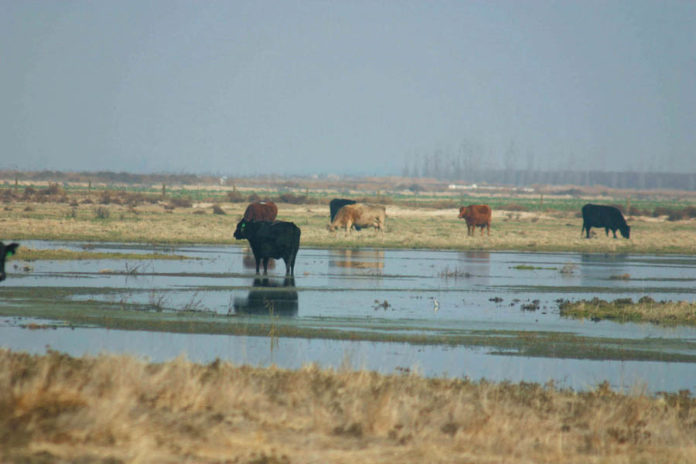With the drought in California a prominent thought and concern for all, it is easy to overlook what our faults can be as agricultural producers. This editorial is neither to blame nor to point fingers, but to provide a new prospective. Let’s dive into the world of rangelands.
Rangelands are so vast and complicated, but modern techniques such as monitoring or range variability make these concepts less tricky. I watched two videos discussing monitoring practices and variability to inform myself as a cattle producer. Video one was hosted by the USDA NCRS while the other was hosted by Lamar Smith, a Range Management Specialist in Arizona. Both covered the aforementioned topics simply and in a manner that any rancher could understand, even a young one like myself. Both also highly corresponded with other topics on ecology, range inventory and monitoring, and range stocking rates.
The first topic discussed was the idea of monitoring rangeland, which was described in one video as “a consistent collection and examination of information to determine if management decisions are meeting specific goals or objectives over an extended period of time.” Monitoring is determined by the goals and objectives of ranchers, researchers, and other range management professionals. Monitoring involves taking photos and recording GPS coordinates, monitoring sites, and the type of vegetation at each site. Monitoring is also important for determining stocking rates and vegetation types on your property. It can also help determine the cover, biomass, plant density, or grazing capacity, all of which should be taken into consideration during this drought.
The Written Note v. the Mental Note
Four different types of grazing surveys also exist: grazing capacity, grazing intensity, rangeland inventory, or trend. All vary but seek to determine the aspects of precipitation, forage production, grazing use, livestock numbers, wildlife numbers, soil health, watershed health, ecological conditions, and photographic records. Monitoring is also important for noting the positive or negative changes in a range during a longer period of time than a rancher could remember on their own. If you are like me, you forget from season to season when you see the new calves littering the ground with their cute faces.
noting the positive or negative changes in a range during a longer period of time than a rancher could remember on their own. If you are like me, you forget from season to season when you see the new calves littering the ground with their cute faces.
When monitoring your land, it is important to remember what kind of plants are within the area being monitored, how many animals are on the range and for how long, as well as the amount of vegetation left post-grazing. The idea of “Take Half, Leave Half” keeps most rangelands from being overgrazed and allows for species to regenerate before the next grazing cycle. In our area, this ideology is not being followed and is really depleting our natural resources for our cows and our families’ future generations. Monitoring is simply completed by choosing a quadrant (of your land) and taking photos, using GPS mapping, storing the photos taken from many angles at each quadrant, and keeping accurate records for future review. Just like any drought researcher, it is important to leave a paper trail and keep documenting EVERYTHING!
rangelands from being overgrazed and allows for species to regenerate before the next grazing cycle. In our area, this ideology is not being followed and is really depleting our natural resources for our cows and our families’ future generations. Monitoring is simply completed by choosing a quadrant (of your land) and taking photos, using GPS mapping, storing the photos taken from many angles at each quadrant, and keeping accurate records for future review. Just like any drought researcher, it is important to leave a paper trail and keep documenting EVERYTHING!
When measuring variability in your rangeland, it is important to note accuracy and precision efforts. Although both have pros and cons, the goal is to be accurate and precise so as not to skew any results of monitoring efforts. It is imperative to select small sites that are fair sampling units such as square quadrants. The monitoring must be repeatable and the records maintained so that anyone can replicate the work that has been done, think succession planning here. The variability may indicate trends in water, stocking rates, and overall range condition. It is imperative to keep the balance of the rangeland to manage it properly so California’s ranchers and producers can keep doing what they do best, being the original environmentalists without all the politics.
succession planning here. The variability may indicate trends in water, stocking rates, and overall range condition. It is imperative to keep the balance of the rangeland to manage it properly so California’s ranchers and producers can keep doing what they do best, being the original environmentalists without all the politics.
The next time you go out into your fields and scout, be sure to think about how your decisions today affect your kids, their kids, and their children’s children. Droughts may happen, but it’s our job to be vigilant of water consumption, storage, and delegation.
 In addition to being www.WaterWrights.net ‘s Social Media Coordinator Jackie Taylor is farmer and rancher in Fresno County, a Fresno State University Grad Student and a member of California Women for Agriculture.
In addition to being www.WaterWrights.net ‘s Social Media Coordinator Jackie Taylor is farmer and rancher in Fresno County, a Fresno State University Grad Student and a member of California Women for Agriculture.
DISCLAIMER OF RESPONSIBILITY; Waterwrights strives to provide its clients with the most complete, up-to-date, and accurate information available. Nevertheless, Waterwrights does not serve as a guarantor of the accuracy or completeness of the information provided, and specifically disclaims any and all responsibility for information that is not accurate, up-to-date, or complete. Waterwrights’ clients therefore rely on the accuracy, completeness and timeliness of information from Waterwrights entirely at their own risk. The opinions expressed in this report are those of the author and do not represent any advertisers or third parties.
ALL RIGHTS RESERVED. Copyright 2022 by WaterWrights.net/DAW

































